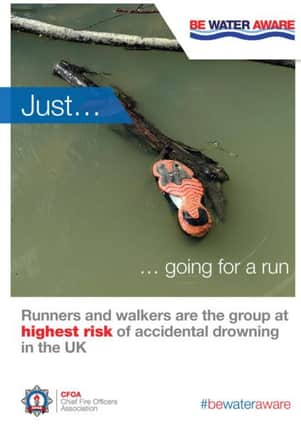Fire service reveals it has rescued 88 people from water since 2009 in Northamptonshire as safety week launches


Northamptonshire Fire and Rescue Service (NFRS) is supporting the nation CFOA Drowning Prevention and Water Safety Week, which starts today.
According to the Chief Fire Officers Association (CFOA), which runs the campaign, national figures reveal that 302 people accidentally drowned in 2014. A total of 44 per cent of these people were taking part in everyday activities such as walking or running near water.
Advertisement
Hide AdAdvertisement
Hide AdSince 2009, Northamptonshire Fire & Rescue Service has rescued 88 people from water, including nine people who died and eight people who were injured. In the year 2015-2016 alone, 19 people were rescued from water. These rescues included a variety of circumstances, such as multiple cases involving people who were freed from cars stuck in water.
NFRS’s brigade manager, Dawn Whittaker, who is also the national Water Safety lead for CFOA, said: “In Northamptonshire, we are lucky enough to have beautiful rivers, lakes and canals for people to enjoy and we want to ensure people do so safely.
“The CFOA Drowning Prevention and Water Safety Week gives us a great opportunity to ensure people are reminded of the risks of open water and how to stay safe. More than 400 people lose their lives in water every year in the UK. We want to do our part to ensure that our communities are safe.”
NFRS, Northamptonshire Police and Northamptonshire Sport are among the organisations involved in the Northamptonshire Water Safety Forum which meets several times a year to ensure water safety messages reach people within the county in the right way.
Advertisement
Hide AdAdvertisement
Hide AdThe forum will also be supporting the Royal Life Saving Society UK’s Drowning Prevention Week (June 18-16), when a number of events will be held in Northamptonshire, including a special water safety day at Nene Whitewater Centre in Northampton, to which students from four secondary schools will be invited.
Forum chair Steve Jackson said: “Many of those who end up drowning or getting into difficulties in water are people who never intended to be in the water. They could be walkers, runners and people who get too close to the bank and fall in.
“It is common practice to walk around water and we are not saying not to go there, but we are reminding people to be aware of their surroundings. Keep a distance away from banks so if you do accidentally trip, you won’t end up in the water.”
About 400 people needlessly drown in the UK every year and thousands more suffer injury, some life changing, through near-drowning experiences. Putting this into context, one person dies every 20 hours in the UK.
Advertisement
Hide AdAdvertisement
Hide AdThe first ever UK national drowning prevention strategy was launched in Westminster in February 2016 and is a product of collaboration between the many organisations involved in the UK National Water Safety Forum. Its key aim is to reduce water related fatalities by 50 per cent by 2026.
Ten tips for water safety:
1) If someone falls into deep water, call 999. If you are near the coast ask for the coastguard, if you are inland ask for the fire service and ambulance.
2) Never enter the water to try and save someone. This usually ends up adding to the problem. If you go into the water you are likely to suffer from cold water shock, which will leave you unable to help.
3) In an emergency, look around for any lifesaving equipment. Depending on where you are, there might be lifebelts or throw bags – use them. If there is no lifesaving equipment, look at what else you can use. There may be something that can help them stay afloat – even an item such as a ball can help.
Advertisement
Hide AdAdvertisement
Hide Ad4) You could attempt to reach out to someone struggling in water. Clothes such as scarves, or long sticks could be used. If you do this, lie on the ground so your entire body is safely on the edge and reach out with your arm. Don’t stand up or lean over the water.
5) If you manage to get the person out of the water, they will always need medical attention. Even if they seem fine, drowning can occur at a later stage if water has already entered the lungs.
6) When fishing, check that the spot you have chosen is safe. Remember that riverbanks can erode.
7) Avoid throwing sticks or balls near water for dogs – they will go after something if they think you want it back, even if you’ve thrown it too far or into dangerous water.
Advertisement
Hide AdAdvertisement
Hide Ad8) Never enter the water to try and save a dog – the dog usually manages to scramble out.
9) Remember that alcohol reduces inhibitions and can mean you take more risks. If you fall into water after drinking, your chances of being able to get out of the water are decreased due to alcohol’s impairment of simple movements.
10) If fishing, make sure you let someone know where you are going.
For more guidance on keeping safe near water, see www.nationalwatersafety.org.uk